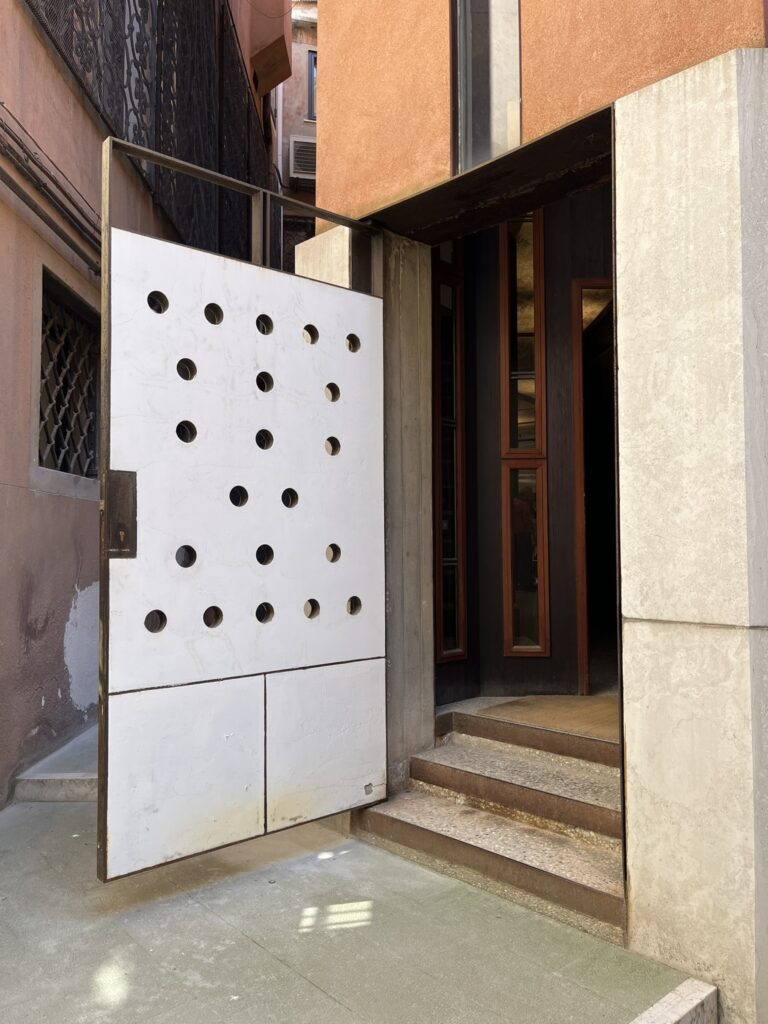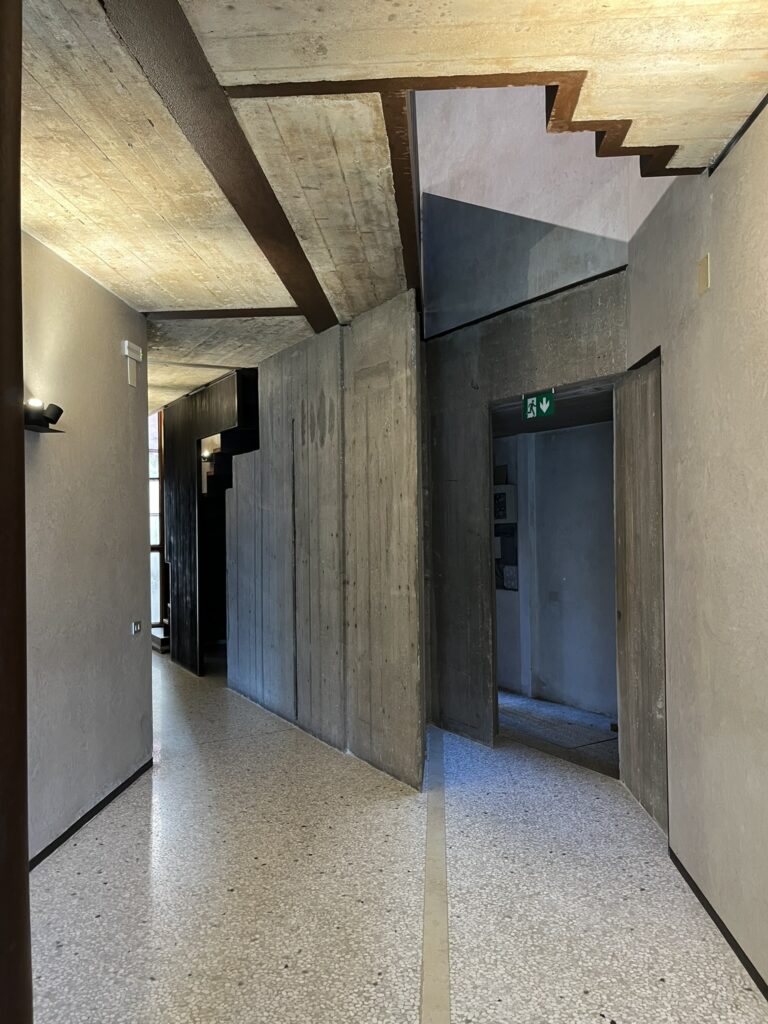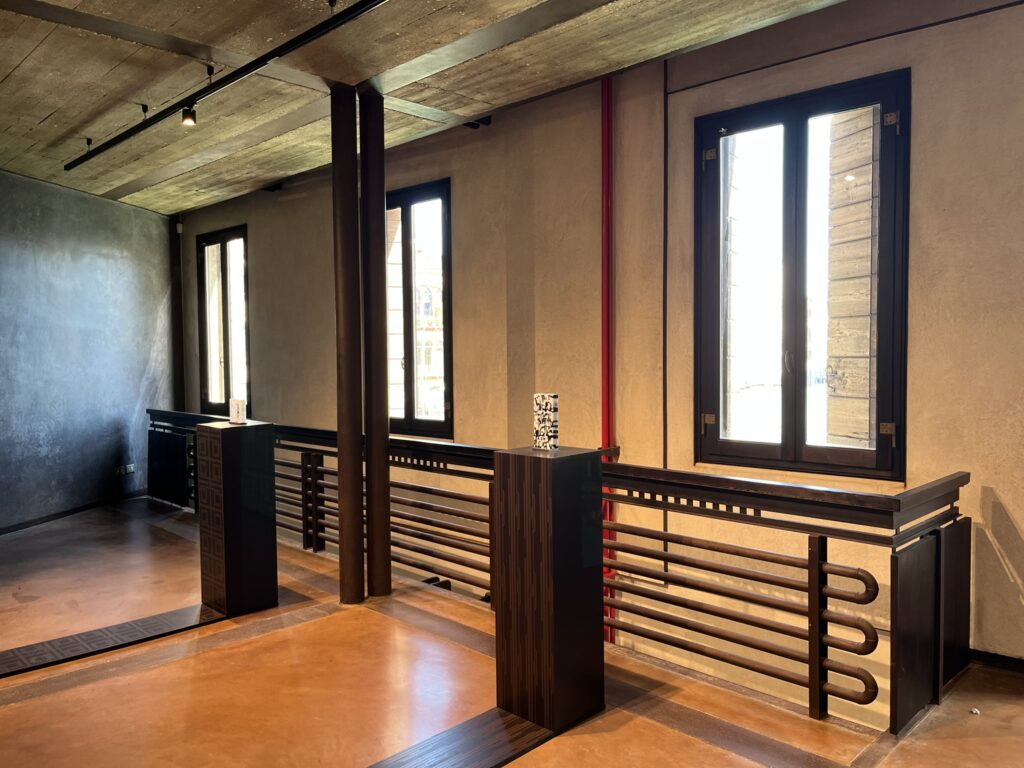You might have spotted the palazzina tucked between larger palazzos along Canal Grande, near the wide bend by Ca’ Foscari. However, finding the entrance to Palazzina Masieri is a bit trickier, but it’s well worth the effort. Recently opened to the public in 2024, it offers a unique opportunity to explore a hidden masterpiece by Carlo Scarpa, one of Venice’s most influential 20th-century architects. Once you find it, and figure out how to get inside, you will be blown away by its beauty.
In this post, I will talk about the history of the palazzina and the restoration by Carlo Scarpa. I will also give you a feel of the exhibition which is currently ongoing and which is part of the Architecture Biennale. Finally, I will tell you how to get inside.
History of Palazzina Masieri
Shortly before his death, architect Angelo Masieri asked the American architect Frank Lloyd Wright to renovate his family’s pre-19th-century building in the ‘Volta di Canal Grande’. The city of Venice rejected the proposal, considering it inappropriate to construct new buildings within Venice’s historic fabric. In 1968, the Masieri Foundation asked the renowned Venetian architect Carlo Scarpa to redesign the interior of the Palazzina while preserving the building’s external facade. His restoration works were completed in March 1983.
Since 1996, the Masieri Foundation has been an active center for cultural production in the field of architecture. Besides its exhibition activities, which featured works by Tadao Ando, Aldo Rossi, Frank Gehry and many others, the Foundation was also involved in publishing. It was the editorial office for the magazine initially called ‘Il Giornale’ and later renamed ‘Phalaris’, which was the first Italian bimonthly publication to combine sections on current affairs, politics, art, fashion, theater, and architectural projects. The Foundation also established an architecture documentation center, including the creation of an archive with materials related to contemporary projects, particularly those concerning the city of Venice. This is now carried out through the Archivio Progetti at the Iuav University of Venice.
In 2024, after a long period of inactivity and closure, Palazzina Masieri reopened its doors. This followed significant redevelopment work initiated by Iuav and in collaboration with Galerie Negropontes and Heritage Asset Management.
Since March 2024, Palazzina Masieri hosts art exhibitions curated by Galerie Negropontes, but always in line with the original spirit of the Masieri Foundation.


Carlo Scarpa
Carlo Scarpa (1906 – 1978) is an important Venetian architect from the 20th century. He is known for his instinctive approach to materials, combining artisanal techniques with modern production methods. His architecture is deeply rooted in Venice, yet also influenced by Japanese culture and numerology. His style is instantly recognisable: a careful choreography of concrete, steps, tiles, squares, water, and shifting levels, often in muted tones of grey. He was also obsessed with details, such as the relationship between floor and walls. Watch, for instance, the stunning and inventive design of the heating installation in the palazzina, which seamlessly integrates functionality with aesthetics.
Ever since childhood, he wanted to become a painter so his father motivated him to pursue a career in design. As he was also fascinated by architecture, he studied at the Accademia di Belle Arti (Fine Arts) in Venice, but he refused to take part in the professional exam for architects.
Many of his projects are located in Venice, and you might have admired them without realising this. Besides the Palazzina Masieri, a few examples are the Aula Baratto in Ca’ Foscari, Negozio Olivetti on Piazza San Marco, Fondazione Querini Stampalia, and the pavilion of Venezuela in Giardini. Keep your eyes open. His work can be found all across the city.
When Carlo Scarpa was 19, he started working for Giacomo Cappellin, one of the most important and very passionate glassmasters in Murano. Together they created glass objects unlike anything seen before: geometrical, bathed in gold, elegant, transparent, richly coloured, and opaque. Later, he was hired by Paolo Venini, another important glassmaster in Murano, as an artistic consultant. Here, he redefined the parameters of glassblowing in terms of aesthetics and technical innovation, and thoroughly modernized the ancient tradition of glassblowing.
If you want to know more about his 58 projects, I can recommend the book ‘Carlo Scarpa: Architecture and Design’. It has more than 250 amazing pictures and lots of information.


Exhibitions
This stunning architectural setting is the perfect backdrop for the ‘Architectural Landscapes’ exhibition. The bronze flower-shaped sculptures by Gianluca Pacchioni, combined with the Pinton green tapestry on the wall, create the impression of a garden. The installation refers to the Giardino Masieri concept by Venetian architect Duilio Torres. On the first floor, the glass sculptures of Perrin & Perrin are delicate and contrast with the brutal design of Carlo Scarpa. These glass sculptures beautifully echo his early career in glassmaking.
The current exhibition is a collateral event of the 2025 Architecture Biennale, and one of the projects of the Venice pavilion scattered around the city. As I adore the place, it is included in my book ‘The insider guide to the Venice Architecture Biennale 2025’ as one of the visually stunning pavilions.
Other exhibitions will follow when the Biennale finishes. Keep an eye on the website or social media of Galerie Negropontes to know what’s going on while you’re in Venice.


How to visit Palazzina Masieri
Visiting the Palazzina is free and open to all, but upfront reservation is required. Just email venezia@negropontes-galerie.com with your request and availability, and the team will set up an appointment with you.
The entrance to Palazzina Masieri isn’t straightforward as it’s not clearly marked on the outside. From Ca’ Foscari, cross Rio Ca’ Foscari, take the first street on the right and then turn left. When you reach Rio de la Frescada, turn right on the Fondamenta and again into Calle Venier. Palazzo Fondazione Masieri is around the corner, on the right, in Calle del Remer. Look for the number 3900 and ring the bell at Galerie Negropontes.
Palazzina Masieri was one of the recommendations from Federico and Paolo. After your visit, you can follow in their steps to discover more hidden gems in Dorsoduro. Check out ‘A walk across Dorsoduro with Federico and Paolo’ for more information.
Enjoy your discovery!
Location: Fondazione Masieri, Calle del Remer, Dorsoduro 3900
More information: negropontes-galerie.com, www.masieri.org
